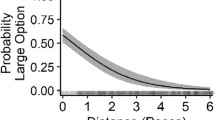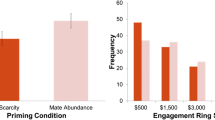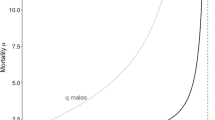Abstract
Many animals prefer small local benefits to large but temporally or spatially distant benefits, and this preference is termed “temporal discounting” or “spatial discounting.” Although temporal discounting has been studied in many taxa, only a limited number of papers have primarily focused on spatial discounting. Here, a mate-choice experiment was conducted using female house crickets (Acheta domesticus) tasked with selecting between a non-attractive local male and an attractive distant male; training procedures were not performed. The results showed that females that had never heard the calling songs of males exhibited spatial discounting behavior. This finding may be key to determining the fundamental differences between temporal and spatial discounting.

Similar content being viewed by others
References
Aho K, Derryberr D, Peterson T (2014) Model selection for ecologists: the worldviews of AIC and BIC. Ecology 95(3):631–636
Ainslie GW (1974) Impulse control in pigeons. I. J Exp Anal Behav 21:485–489
Bateson M, Kacelnik A (1996) Rate currencies and the foraging starling: the fallacy of the averages revisited. Behav Ecol 7(3):341–352
Fawcett TW, McNamara JM, Houston AI (2012) When is it adaptive to be patient? A general framework for evaluating delayed rewards. Behav Proc 89:128–136
Gray DA (1997) Female house crickets, Acheta domesticus, prefer the chirps of large males. Anim Behav 54:1553–1562
Hedrick AV, Dill LM (1993) Mate choice by female crickets is influenced by predation risk. Anim Behav 46:193–196
Mizuyama R, Uno L, Matsushima T (2016) Food variance and temporal discounting in socially foraging chicks. Anim Behav 120:143–151
Mühlhoff N, Stevens JR, Reader SM (2011) Spatial discounting of food and social rewards in guppies (Poecilia reticulata). Front Psychol 2:11
Murphy CG (2002) Mate sampling by female barking treefrogs (Hyla gratiosa). Behav Ecol 13:472–480
Pelé M, Dufour V, Micheletta J, Thierry B (2010) Long-tailed macaques display unexpected waiting abilities in exchange tasks. Anim Cogn 13:263–271
Pelé M, Dufour V, Micheletta J (2011) Thierry B (2011) Delay maintenance in Tonkean macaques (Macaca tonkeana) and brown capuchin monkeys (Cebus apella). Int J Primatol 32:149–166
Rantala M (2003) Courtship song and immune function in the field cricket Gryllus bimaculatus. Biol J Lin Soc 79:503–510
Richards JB, Mitchell SH, Wit H, Seiden LS (1997) Determination of discount functions in rats with an adjusting-amount procedure. J Exp Anal Behav 67:353–366
Ryder J, Siva-Jothy MT (2000) Male calling song provides a reliable signal of immune function in a cricket. Proc R Soc Lond B 267:1171–1175
Shane F, Loewenstein G, O’donoghue T (2002) Time discounting and time preference: a critical review. J Econ Lit 40:351–401
Sozou PD (1998) On hyperbolic discounting and uncertain hazard rates. Proc R Soc Lond B 265:2015–2020
Stephens DW, Anderson D (2001) The adaptive value of preference for immediacy: when shortsighted rules have farsighted consequences. Behav Ecol 12(3):330–339
Stevens JR, Rosati AG, Ross KR, Hauser MD (2005) Will travel for food: spatial discounting in two new world monkeys. Curr Biol 15(20):1855–1860
Stout JF, DeHaan CH, McGhee RW (1983) Attractiveness of the male Acheta domesticus calling song to females. J Comp Physiol 153(4):509–521
Acknowledgments
Y. O. received assistance from K. Gohtsu for the data analysis. We thank the anonymous referees for their many helpful comments and suggestions.
Funding
This work was supported in part by grants-in-aid from the Ministry of Education, Culture, Sports Science and Technology of Japan to E. H. (nos. 22370010 and 26440228) and J. Y. (Nos. 22255004, 26257405, 15H04420 and 22370010). The funders had no role in the study design, data collection or analysis, decision to publish, or preparation of the manuscript. No additional external funding was received for this study.
Author information
Authors and Affiliations
Contributions
Y. O. and E. H. devised the study design, Y. O. conducted the experiments, J. Y. presented the interpretations of the experiments, and Y. O., E. H., and J. Y. wrote the manuscript.
Corresponding author
Ethics declarations
Conflict of interests
Y. O., J. Y., and E. H. declare no conflict of interest.
Ethical approval
All applicable international, national, and/or institutional guidelines for the care and use of animals were followed. This article does not include any studies with human participants conducted by any of the authors.
About this article
Cite this article
Ohkubo, Y., Yoshimura, J. & Hasegawa, E. Cricket mate selection as a spatial discounting phenomenon without learning. J Ethol 36, 229–233 (2018). https://doi.org/10.1007/s10164-018-0552-1
Received:
Accepted:
Published:
Issue Date:
DOI: https://doi.org/10.1007/s10164-018-0552-1




